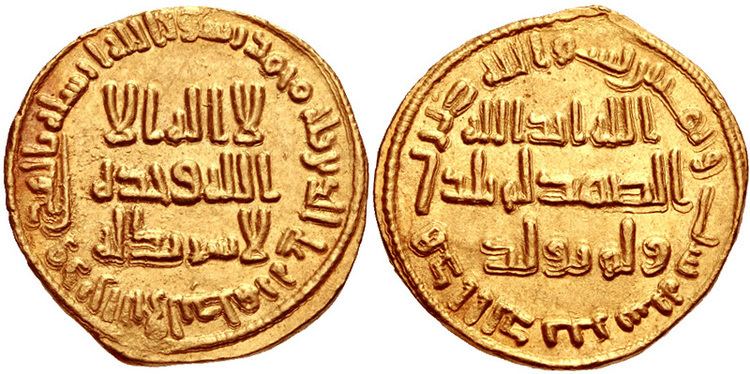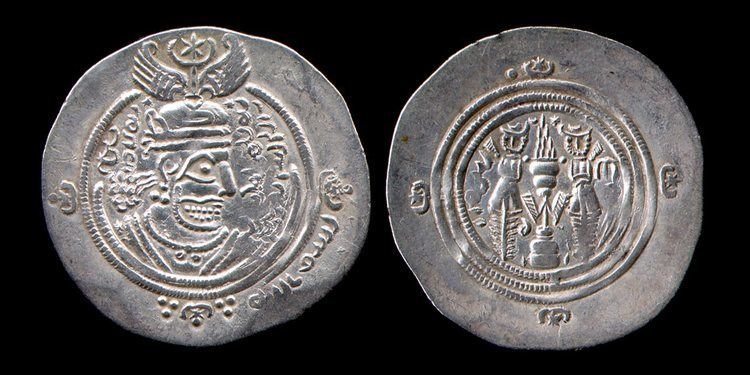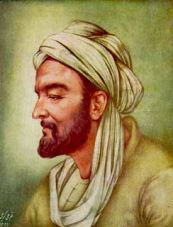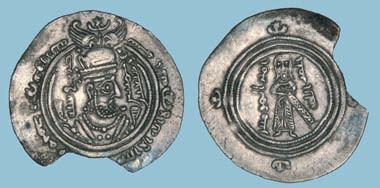Reign 685–705 Name Abd ibn Role Polit. | Siblings Abd al-Aziz ibn Marwan Dynasty Umayyad | |
 | ||
Spouse Walida bint Alabbas, Fatima bint Hisham, Atikah bint Yazid Children Al-Walid I, Hisham ibn Abd al-Malik Parents Marwan I, 'Aisha bint Mu'awiyah Similar Marwan II, Umar II, Yazid I 5th Caliph of the Umayyad Caliphate (Reign) 12 April 685 – 9 October 705 Predecessor Marwan I Successor Al-Walid I Born July/August 644 or June/July 647 Medina, Rashidun Caliphate Died 9 October 705 (aged 58–61) Damascus, Umayyad Burial Outside of Bab al-Jabiya, Damascus House Marwanid Dynasty Umayyad Father Marwan I Mother A'isha bint Mu'awiya Religion Islam | ||
Abd al malik ibn marwan
Abd al-Malik ibn Marwan (Arabic: عبد الملك بن مروان ‘Abd al-Malik ibn Marwān, 646 – 8 October 705) was the 5th Umayyad caliph. He was born in Medina, Hejaz, Abd al-Malik was a well-educated man and capable ruler who was able to solve many political problems that impeded his rule. The 14th-century Muslim historian Ibn Khaldun stated that "`Abd al-Malik ibn Marwan is one of the greatest Arab and Muslim caliphs. He followed in the footsteps of `Umar ibn al-Khattab, the Commander of the Believers, in regulating state affairs".
Contents
- Abd al malik ibn marwan
- Early life
- Campaigns in Iraq and Hejaz
- Campaigns in North Africa
- Byzantines and Anatolia
- Reforms
- Art and architecture
- Death
- References

During his reign, all important records were translated into Arabic, and for the first time, a special currency for the Muslim world was minted, which led to war with the Byzantine Empire under Justinian II. The Byzantines were led by Leontios at the Battle of Sebastopolis in 692 in Asia Minor and were decisively defeated by al-Malik after the defection of a large contingent of Slavs. The Islamic currency was then made the only currency of exchange in the Muslim world. Also, many reforms happened in his time relating to agriculture and commerce. Al-Malik extended and consolidated Muslim rule, made Arabic the state language and organised a regular postal service.

Early life

Abd al-Malik spent most of his early life in Medina with his father. There, he developed useful relationships with the religious circles of the city. He studied Islamic jurisprudence under Umm Darda as Sughra in Damascus. At 16, he was given limited responsibilities by Muawiya II. In 683, he and his father were driven out of Medina by local rebels. On the way to Damascus, he crossed paths with the Syrian army, entailed with the task of ending the rebellion.

He was responsible for the giving of useful advice and information that helped to end that problem. His father was appointed to be caliph in 684 but only created a feud between the northern and southern Arab tribes.
Campaigns in Iraq and Hejaz
Abd al-Malik became caliph after the death of his father Marwan I in 685, amidst the ongoing Second Fitna. Within a few years, he dispatched armies on a campaign to reassert Umayyad control over the Islamic empire. He first defeated the governor of Basra, Mu'sab ibn al-Zubayr. In Iraq, he was facing three distinct groups (the Kharijites, Shi'a, and Abd-Allah ibn al-Zubayr and his followers) that were fighting amongst themselves and against Umayyad control. Al-Zubayr was the more dangerous of the three, as he had been named caliph in Mecca and other provinces were getting behind him. Abd al-Malik bided his time for three years while they weakened themselves. During this hiatus, al-Zubayr's brother, Mus'ab, defeated the Shi'a in 687, which allowed them to commit a large force against the Kharijites.
Abd al-Malik then appointed one of his most able generals and administrators who would later change the face of the Umayyad Empire, al-Hajjaj bin Yousef to march against al-Zubayr, the now-governor of Hejaz. He was initially unsuccessful in 689, as he needed to return to Damascus to help quell a rebellion. Again, in 690, he met with failure. Only after the northern tribes had finally capitulated in 691 did success start. He defeated the weakened army of Mus'ab by bribing many of his soldiers to switch sides and kill their leader.
He then turned his attention to the caliph, al-Zubayr. It should be noted that al-Zubayr controlled a large majority of the empire outside Umayyad core in Syria and Egypt, and more importantly, controlled Mecca and Medina. Ibn-al Zubayr was a living sahabah of Muhammad who stood opposed to Umayyad rule. Hajjaj besieged Mecca in 692 with almost 12,000 Syrian troops. He advanced unopposed as far as his native Taif, which he took without any fighting and used as a base. The caliph had charged him first to negotiate with al-Zubayr and to assure him of freedom from punishment if he capitulated or, if opposition continued, to starve him out by siege, but on no account to let the affair result in bloodshed in Mecca. Since the negotiations failed and al-Hajjaj lost patience, he sent a courier to ask Abd al-Malik for reinforcements and also for permission to take Mecca by force. He received both and thereupon bombarded the Holy City using catapults from the mountain of Abu Qubays. The bombardment continued during the month of the Pilgrimage or Hajj.
After the siege had lasted for seven months and 10,000 men, among them two of Abdullah Ibn al-Zubair's sons, had gone over to Hajjaj, Abd-Allah ibn al-Zubayr with a few loyal followers, including his youngest son, were killed in the fighting around the Kaaba (Jumadah I 73/October 692).
Hajjaj's success led Abd al-Malik to assign him the role of governor of Iraq and give him free rein in the territories he controlled. Hajjaj arrived when there were many deserters in Basra and Kufa. He continually faced rebellions from the Kharijites but was always able to put them down. He promptly and forcefully impelled them to return to combat. Hajjaj, after years of serious fighting, quelled religious disturbances, including the rebellion launched by Salih ibn Musarrih and continued after Salih's death by Shabib. The rebels repeatedly defeated more numerous forces and at their height entered Kufah. However, Abd al-Malik's Syrian reinforcements enabled Hajjaj to turn the tide.
By 697, the Kharijites were no longer much of a problem. Under Hajjaj, Arab armies put down the revolt of Abd al-Rahman ibn Muhammad Ibn al-Ash'ath in Iraq and Afghanistan from 699 to 704 and also took most of Turkestan. Abd al-Rahman rebelled after Hajjaj's repeated orders to push further into the lands of Zundil. After his defeat in Iraq, again achieved through Abd al-Malik's dispatch of Syrian reinforcements to Hajjaj, Abd al-Rahman returned east. There, one city closed its gates to him, and in another, he was seized. However, Zundil's army arrived and secured his release. Later, Abd al-Rahman died and Zundil sent his head to Hajjaj, who sent it to Abd al-Malik. These victories paved the way for greater expansions under Abd al-Malik's son Al-Walid.
Hajjaj decided that the best way to rule Iraq was to treat them as enemy territory. He built a new city, Wasit, which he used as a garrison city for his Syrian troops and also as his private residence.
Campaigns in North Africa
He was effective in increasing the size of the empire. In Maghreb (western North Africa) in 686, a force led by Zuhayr ibn Qais won the Battle of Mamma over Byzantines and Berbers led by Kusaila, on the Qairawan plain, retaking Ifriqiya and its capital Kairouan.
In 695, Hasan ibn al-Nu'man captured Carthage with the help of the Berbers, and advanced into the Atlas Mountains. A Byzantine fleet arrived, retaking Carthage, but in 698 al-Nu'man returned and defeated Tiberios III at the Battle of Carthage. The Byzantines withdrew from all of Africa except Ceuta.
Hasan met trouble from the Zenata tribe of Berbers under al-Kahina. It inflicted a serious defeat on him and drove him back to Barqa. However, in 702, Abd al-Malik strongly reinforced Hasan. Now with a large army and the support of the settled population of North Africa, Hasan pushed forward. He decisively defeated the Zenata in a battle at Tabarka, 85 miles west of Carthage. He then developed the village of Tunis, 10 mi from the destroyed Carthage. Around 705, Musa ibn Nusayr replaced Hasan. He had pacified much of Northern Africa despite his failure to take Ceuta.
Byzantines and Anatolia
Relations between the Arabs and the Byzatines along their border in Anatolia had been calm since 680, with a truce largely holding up. Emboldened by success in his European provinces, however, Byzantine Emperor Justinian II managed by threat to augment the sum paid by the Umayyad Caliphs as an annual tribute, and to regain control of part of Cyprus. The incomes of the provinces of Armenia and Iberia were divided among the two empires. In 687, as part of his agreements with the Caliphate, Justinian removed from their native Lebanon 12,000 Christian Maronites, who continually resisted the Arabs. In 688, Abd al-Malik signed a treaty with Justinian II which rendered Cyprus neutral ground, with its tax revenue split. In 692, he resumed fighting in Anatolia and in that year Abd al-Malik fought and won the Battle of Sebastopolis (mostly identified with Elaiussa Sebaste in Cilicia but also with modern Sulusaray). Initially looking like a defeat, thousands of the Byzantine Emperor's Slavic troops defected, changing the tide of the fight. It was a crushing victory for Abd al-Malik, and ended the peace that had existed between the two powers since 680.
Reforms
Abd al-Malik instituted many reforms such as:
- Making Arabic the official language of government across the entire caliphate.
- Instituting a mint that produced a uniform set of Islamic currency which resulted in war with Byzantine Empire and defeat of the Romans at the Battle of Sebastopolis;
- Expansion and reorganization of postal service,
- Repairing the damaged Kaaba and beginning the tradition of weaving a silk cover for the Kaaba in Damascus.
Art and architecture
He also built the Dome of the Rock in Jerusalem. The Muslim scholar al-Wasiti reports this event:
When Abd al-Malik intended to construct the Dome of the Rock, he came from Damascus to Jerusalem. He wrote, "Abd al-Malik intends to build a dome (qubba) over the Rock to House the Muslims from cold and heat, and to construct the mosque (masjid). But before he starts he wants to know his subjects' opinion." With their approval, the deputies wrote back, "May Allah permit the completion of this enterprise, and may He count the building of the dome and the masjid a good deed for Abd al-Malik and his predecessors." He then gathered craftsmen from all his dominions and asked them to provide him with the description and form of the planned dome before he engaged in its construction. So, it was marked for him in the sahn of the masjid. He then ordered the building of the treasury (bayt al-mal) to the east of the Rock, which is on the edge of the Rock, and filled it with money. He then appointed Raja' ibn Hayweh and Yazid ibn Salam to supervise the construction and ordered them to spend generously on its construction. He then returned to Damascus. When the two men satisfactorily completed the house, they wrote to Abd al-Malik to inform him that they had completed the construction of the dome and al-Masjid al-Aqsa. They said to him "There is nothing in the building that leaves room for criticism." They wrote him that a hundred thousand dinars was left from the budget he allocated. He offered the money to them as a reward, but they declined, indicating that they had already been generously compensated. Abd al-Malik ordered the gold coins to be melted and cast on the Dome's exterior, which at the time had such a strong glitter that no eye could look straight at it.
The two engineers Raja' ibn Hayweh, from Baysan, and Yazid ibn Salam, a Jerusalemite, were ordered to spend generously on the construction. In his Book of the Geography, Al-Muqaddasi reported that seven times the revenue of Egypt was used to build the Dome. During a discussion with his uncle on why the Caliph spent lavishly on building the mosques in Jerusalem and Damascus, al-Maqdisi writes:
O, my little son, thou hast no understanding. Verily he was right, and he was prompted to a worthy work. For he beheld Syria to be a country that had long been occupied by the Christians, and he noted there are beautiful churches still belonging to them, so enchantingly fair, and so renowned for their splendour, as are the Church of the Holy Sepulchre, and the churches of Lydda and Edessa. So he sought to build for the Muslims a mosque that should be unique and a wonder to the world. And in like manner is it not evident that Caliph Abd al-Malik, seeing the greatness of the martyrium of the Holy Sepulchre and its magnificence was moved lest it should dazzle the minds of Muslims and hence erected above the Rock the dome which is now seen there.
Abd al-Malik's first issue of coins replaced images with words, to appease aniconistic clerics. After this, the style became predominant on Islamic coins.
Death
The last years of his reign were generally peaceful. He wanted his son al-Walid I to succeed him, ignoring his father's decree that Abd al-Malik should be succeeded by his brother, Abd al-Aziz. However, al-Malik accepted advice not to create disturbances and so changed his mind. In the event, Abd al-Aziz died before Abd al-Malik, who then had his sons Al-Walid and Sulayman, in that order, accepted as heirs to the throne. To history, Abd al-Malik is known as the "Father of Kings": his four sons succeeded him as the caliph one after another though with Umar II, son of Abd al-Aziz succeeding Sulayman. Abd al-Malik died at al-Sinnabra in 705.
